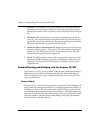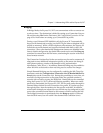
Chapter 1: Understanding ISDN and the Express XL/XLT
61200.070L1-1 Express XL/XLT User Manual 15
IPX Routing
Like IP routing, the Express XL/XLT can connect to two different sites and ex-
change IPX packets. Network routes and services are learned and advertised
using Novell’s RIP and SAP. Routes and services learned from a separate site
can be retained in the Express XL/XLT when the connection goes idle. While
retained, the Express XL/XLT can spoof RIP/SAP and watch-dog and filter se-
rialization packets that would normally be required between the Novell server
and client.
Connection List - Simplifying and Enhancing the Dial Function
The Connection List, which is accessed from the Configuration menu, pro-
vides a location to define information regarding 15 individual destinations
that may be dialed. A Connection List entry is required for each destination
since authentication information (method, username, password), number of
B-channels, telephone numbers, Caller ID, IP, or IPX address (for routed con-
nections), and other information can be stored for each destination defined.
Defined destinations may be dialed by selecting the Dial activator in the Dial
menu or by demand for the desired Connection List profile.
Concurrent Routing And Bridging
The Express XL/XLT can route IP and IPX as well as bridge non-IP/IPX pack-
ets simultaneously. The Connection List profile will by default negotiate PPP
network protocols to support the transmission and reception of IP, IPX, and
Bridge packets. If the PPP peer does not accept a protocol, the Express XL/XLT
will fall back to any combination of routing and bridging.
Routing over PPP Bridging
The Express XL/XLT can support legacy equipment which does not support
PPP IP (IPCP) or IPX (IPXCP) protocols by allowing routing packets over the
WAN connection using PPP Bridging (BCP). To perform this, the Express XL/
XLT uses a “virtual” ethernet port. This port is set up under the Configura-
tion/Bridge menu.


















